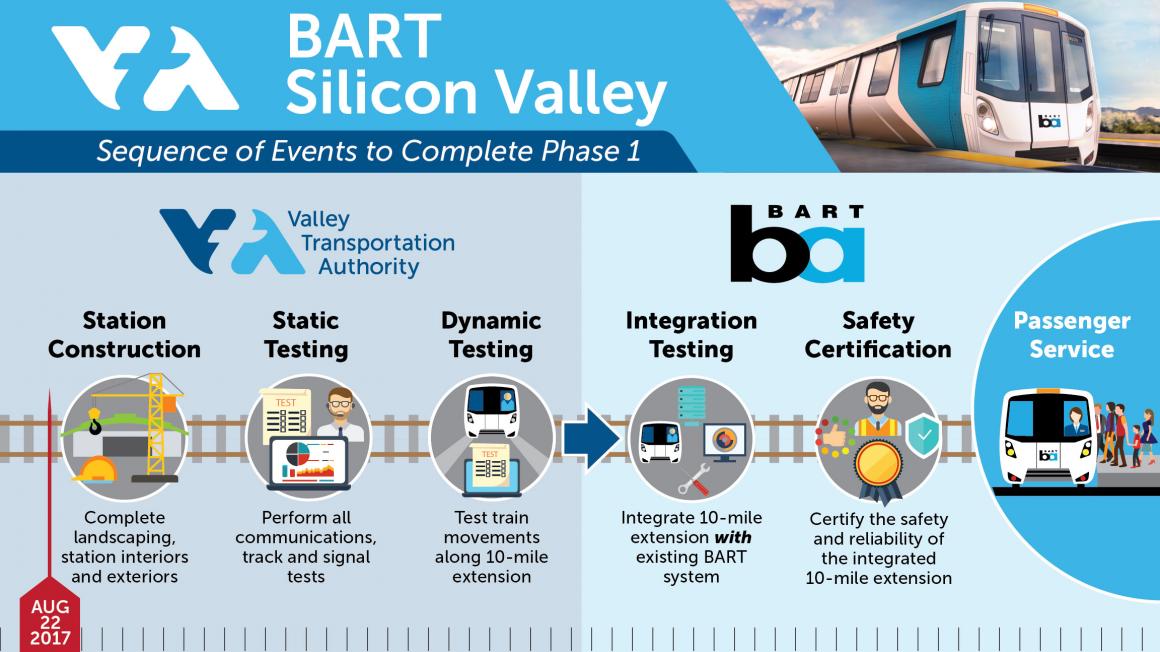Phase I of VTA’s BART Silicon Valley Extension, bringing BART from South Fremont into Milpitas and San Jose (Phase I), is entering into the final and most complicated stretch of the project. It has been quite the journey but we’ve come a long way!
Since breaking ground in April 2012, VTA’s Phase I team has constructed 10 miles of track, two BART stations and campuses, and a number of roadway improvements to fully separate the system from pedestrians, bicyclists and motorists. We have greatly appreciated the patience and cooperation of our neighboring communities as we have worked around the clock to bring BART to Silicon Valley.
View larger timeline graphic.
For most of the five years of construction, VTA has tracked more than six months ahead of our scheduled completion date of June 2018. Once our project began the process of tying into BART’s Warm Springs Extension and system testing started, progress became more dependent on the completion of thousands of tests that must be performed by VTA, VTA’s contractor and BART.
In August, staff updated the Board of Directors on the final milestones necessary to provide fully-integrated, safe and reliable BART service to Silicon Valley. These sequence of events require significant coordination with BART and are dependent on the successful completion of these milestone to be able to open for passenger service:
- Station Construction: Complete landscaping, station interiors and exteriors
- Static Testing: Perform all communications, track and signal tests
- Dynamic Testing: Test train movements along 10-mile extension
- Integration Testing: Integrate 10-mile extension with the existing BART system
- Safety Certification: Certify the safety and reliability of the integrated 10-mile extension
- Passenger Service!
While station construction is scheduled to be completed by the end of this year, the three testing phases that follow require complex tests to be performed, all of which are necessary to assure the safety and reliability of the newly constructed facilities and systems.
First, VTA will perform static testing which includes all track, communications and signal tests along the trackway, in the six train control facilities, and within the two stations. During this time, residents might see trains on the tracks, but most of the work will happen on computers behind the scene. Next, VTA will perform dynamic testing, where train movements will be tested along the 10-mile extension, from Fremont to San Jose. This phase of testing will be visible to the public as multi-car trains will travel along the 10-mile extension to simulate BART service.
Finally, VTA will turn the project over to BART so that BART may perform integration testing and train its operators on the new 10-mile extension. Even after VTA completes all its construction work and testing phases, only BART and regulatory agencies can certify the safety and reliability of the fully integrated extension as being ready for passenger service.
The final milestone is safety certification. The California Public Utilities Commission (CPUC) is the agency that oversees the safety certification of rail transit systems in California. Under CPUC oversight, all systems are certified to ensure they are correctly designed, constructed, installed, and operating as intended. Once these certifications are in place, and the CPUC is satisfied with the process, BART may begin passenger service on the new 10-mile extension. After passenger service begins, BART will be responsible for operations and maintenance of the system, and the CPUC will continue oversight of the system operations.
While we understand that residents are excited about riding the new BART extension into Milpitas and San Jose, it is VTA’s top and unwavering priority to deliver safe and reliable service. We couldn’t have come this far without the continued support and patience we have received from our neighbors. We also appreciate the investment the public has made to see this project reach passenger service, and we are committed to delivering a transit system worthy of that investment.
Wanting more information? We have answers to some frequently asked questions and we're happy to discuss any others we may have missed by emailing or calling VTA's Community Outreach Department at (408) 321-7575.
